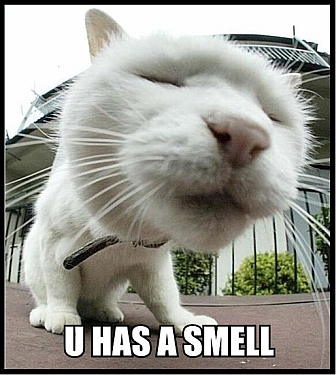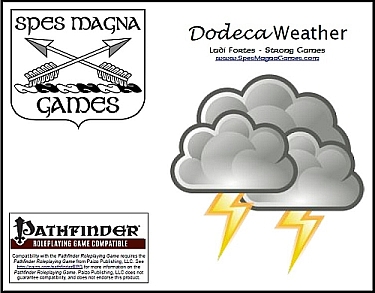Ooh, That Smell!
 Several weeks ago, I read a thread on the Paizo messageboards about the scent extraordinary ability. It was started by a poster confused by the assertion that scent isn’t some sort of automatic enemy detection power that operates in a 30-foot radius. The confusion increased when other posters observed that scent is a natural sense, and that natural senses operate according to the Perception skill.
Several weeks ago, I read a thread on the Paizo messageboards about the scent extraordinary ability. It was started by a poster confused by the assertion that scent isn’t some sort of automatic enemy detection power that operates in a 30-foot radius. The confusion increased when other posters observed that scent is a natural sense, and that natural senses operate according to the Perception skill.
First, let’s take the rules for scent, which are found in at least three different places in the reference document, and consolidate them into one set of rules:
The scent special quality allows a creature to detect approaching enemies, sniff out hidden foes, and track by sense of smell. Creatures with the scent ability can identify familiar odors just as humans do familiar sights.
A creature with the scent ability can detect opponents by sense of smell, generally within 30 feet. If the opponent is upwind, the range is 60 feet. If it is downwind, the range is 15 feet. Strong scents, such as smoke or rotting garbage, can be detected at twice the ranges noted above. Overpowering scents, such as skunk musk or troglodyte stench, can be detected at three times these ranges.
When a creature detects a scent, the exact location of the source is not revealed—only its presence somewhere within range. The creature can take a move action to note the direction of the scent. When the creature is within 5 feet of the source, it pinpoints the source’s location.
A creature with the Survival skill and the scent ability can follow tracks by smell, making a Survival check to find or follow a track. A creature with the scent ability can attempt to follow tracks using Survival untrained. The typical DC for a fresh trail is 10. The DC increases or decreases depending on how strong the quarry’s odor is, the number of creatures, and the age of the trail. For each hour that the trail is cold, the DC increases by 2. The ability otherwise follows the rules for the Survival skill in regards to tracking. Creatures tracking by scent ignore the effects of surface conditions and poor visibility.
Creatures with the scent ability can identify familiar odors just as humans do familiar sights.
Water, particularly running water, ruins a trail for air-breathing creatures. Water-breathing creatures that have the scent ability, however, can use it in the water easily.
False, powerful odors can easily mask other scents. The presence of such an odor completely spoils the ability to properly detect or identify creatures, and the base Survival DC to track becomes 20 rather than 10.
Creatures with the scent special quality have a +8 bonus on Perception checks made to detect a scent.
As the Perception skill notes (emphasis added), “Perception covers all five senses, including sight, hearing, touch, taste, and smell.” The skill’s text further clarifies that “Perception is also used to notice fine details in the environment. The DC to notice such details varies depending upon distance, the environment, and how noticeable the detail is.” Thereafter in the rules follows a table with several guidelines. Let’s take those guidelines, and tweak them where necessary to apply to the scent extraordinary ability.
Table: Scent Perception Guidelines
Detail: Perception DC
Notice the stench of rotting garbage: -10
Detect the smell of smoke: 0
Determine if food is spoiled: 5
Identify a common smell: 10*
Detect a creature: 15
Identify an uncommon smell: 20*
Perception Modifiers: DC Modifier
Distance to the source, object, or creature: +1/10 feet
Through a closed door: +5
Through a wall: +10/foot of thickness
Favorable conditions (note 1): -2
Unfavorable conditions (note 1): +2
Terrible conditions (note 2): +5
Creature making the check is distracted: +5
Creature making the check is asleep: +10
Creature or object is odorless: +20
* This assumes the creature making the check has encountered the scent before. Otherwise, the GM is justified in requiring an appropriate Knowledge check.
Note 1: Favorable or unfavorable conditions include wind direction and the amount of background “noise” from competing odors. For example, if the sensing creature is downwind from the target, the favorable condition modifier would apply. If the sensing creature were in a perfumery, the unfavorable condition modifier might apply.
Note 2: Terrible conditions are like unfavorable conditions, but moreso. For example, an overpowering stench covering the area would apply the terrible conditions modifier.
Perception also notes that “the most common [Perception check] is an opposed check versus an opponent’s Stealth check to notice the opponent and avoid being surprised.” This, however, doesn’t seem appropriate when dealing with scent. Stealth’s description at least heavily implies it is limited to avoiding detection via sight and hearing. This prompts a question: How does a creature actively avoid detection by another creature using the scent extraordinary ability? Two skills seem most applicable: Knowledge and Survival. Let’s start with the latter.
Survival deals with “surviving in the wild”. It seems reasonable that this includes the knowing what needs to be done to avoid detection via scent. In most situations, avoiding scent detection is covered under the “hunting and foraging” application of Survival. A survivalist can be more proactive. Given appropriate equipment and 1 minute, the survivalist can make a Survival check. The result is treated as the base DC for scent-based Perception checks. These preparations fade at a rate of -2 DC per hour under normal conditions, but the survivalist can always reapply his scent countermeasures (making a new Survival check to set a new scent-based Perception check DC).
Knowledge skills can also give a survivalist an advantage in that the survivalist can tailor his scent to be more undetectable to a specific type of creature (such as animals or magical beasts). This requires the survivalist to have at least 1 rank in the applicable Knowledge skill, such as Knowledge (nature) for animals or Knowledge (arcana) for magical beasts. The survivalist must make a DC 15 Knowledge check. If successful, he adds +2 to his Survival check to mask his scent, +1 more for every 5 points over 15 he scores.
Now, let’s put all of this together.
Rob, a ranger, and his wolf animal companion Tejas explore a complex of caves and tunnels. The GM knows Rob and Tejas are nearing a cave in which several troglodytes have recently fought and killed an intruding ogre. The trogs pick over the ogre’s corpse while Rob and Tejas approach.
Tejas has the scent extraordinary quality. In this section of the caves, the trogs are downwind of Rob and Tejas as cooler surface air flows down into the warmer caverns. Downwind sets a scent range of 15 feet, but this is tripled to 45 feet due to the trogs’ stench.
The GM rules the base DC is -10 since the trogs’ stench is at least as noxious as rotting garbage. The air currents are not favorable to Tejas, increasing the DC to -8. At 45 feet, the closest range that Tejas can detect the trogs, a further +4 modifier is applied to the DC, yielding a final DC of -4, which is child’s play for the wolf’s keen nose. At a range of 45 feet, Tejas detects the trogs and growls a warning to Rob. At this time, Tejas only knows the scent is within range. If Tejas takes a move action, he can determine the direction of the scent.
Unfortunately for Rob and Tejas, they are also being stalked. A doppelganger has picked up their trail and follows at a range of about 90 feet. The doppleganger is upwind of Tejas, but it doesn’t have a particularly strong odor. Thus, the doppelganger is out of Tejas’s scent range of 60 feet (30 feet doubled for the target being upwind).
As Rob and Tejas approach the trogs, they slow down to move stealthily. The doppelganger is not immediately aware of this, but by the time it’s within 60 feet of Tejas, the adventurer and his wolf are also fairly close to the trogs.
The base DC to detect a creature is 15. A -2 modifier for favorable conditions applies since the doppelganger is upwind, but a +5 modifier for terrible conditions also applies due to the pervasive trog-stink. A range of 60 feet imposes a further +6 modifier, yielding an initial 24 DC. Tejas can probably make this Perception check. If he doesn’t and the doppelganger waits until Rob and Tejas fight the trogs, a further +5 DC modifier for being distracted might be applicable.
Let’s say the doppelganger has ranks in Knowledge (nature) and Survival. It takes time to mask its scent before tracking Rob and Tejas. It gets a 25 on its Survival check and a 20 on its Knowledge (nature) check. This latter check grants a +3 bonus to the Survival check result. In this scenario, instead of a base scent Perception DC of 15, Tejas confronts a base DC of 28, not including modifiers for conditions, range, et cetera. Suddenly, Tejas’s ability to warn Rob of the doppelganger’s presence doesn’t look so promising.
These rules helps define scent’s limitations while at the same time leaving creatures with the scent extraordinary ability an impressive level of awareness of their environment. Allowing Knowledge and Survival to work as scent countermeasures adds new tactical options that reward investment in these skills not only for PCs but also for NPCs and monsters.




